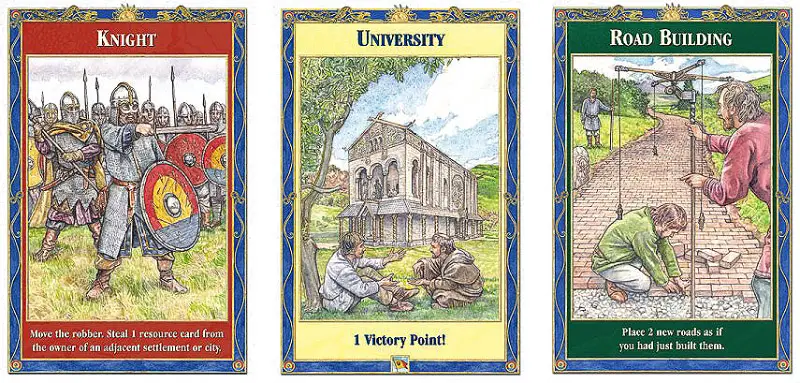For this critical play, I will discuss Settlers of Catan, a German-style board game designed by Klaus Teuber. The target audience is players of age 10+ as listed on the game box.
Important Formal Elements, types of fun, and improvement
Catan is a multiplayer game. The objective of the game is to be the first player to reach 10 victory points. The game revolves around building roads and settlements, which count for victory points, on the game map by obtaining resources. The first procedural item is to build two “free” settlements and roads, and then players begin rolling dice to retrieve the resources on which they have settlements with the rolled tile numbers. The resources include resource cards, which are wood, brick, sheep, grain, and ore. There are also development cards—which are special actions, abilities, or even a free victory point—a robber, ports, and “Longest Road” and “Largest Army” achievements.
A major type of fun for Catan is Challenge. The strategic playing required to achieve the objective using the resources as mentioned above, along with a different environment each game and always multiple paths to success, make the game truly a Challenge. The ever-popular game certainly succeeds in this goal by leveraging different resource types and mechanics to make a competitive and stimulating activity, and this type of fun is also the reason why I enjoy the game.
One potential place of improvement that I think about is the role of the robber. I am unsure, but it seems to me that many of the development cards are Knight cards. Since seven is a commonly rolled number, I am often disappointed when I draw a Knight card as my development card because I will not find it very useful. Perhaps there could be less of these cards, perhaps they are actually more helpful than I have experienced, perhaps they are a way to balance the value and power of purchasing development cards in the game, or perhaps there aren’t even as many as I am suggesting.
Balance
Game balance
The four types of game balance are balance in single-player games, balance in asymmetric games, balance between strategies in a game, and balance between game objects, and the types that are relevant to Catan are all but the first. For balance in asymmetric games, players can start off asymmetrically because of where they put their initial settlements (and roads). Some will be more advantageous than others. This is balanced by the order in which players can place their initial settlements (first person goes, then second, third, third, second, first). For balance between strategies in a game, there are definitely multiple strategies players can employ to successfully win the game. Some strategies include dedicating more to accumulating development cards and achieving the two titles, increasing production early on, covering ground in terms of having access to all resources, and more. (The former is the strategy that I tend to employ every time I play the game, so it always feels like an epic success when I do end up winning using this planned strategy, especially when I get to reveal a free victory point as the surprise at the end.) Lastly, for balance between game objects, I think there is a good balance between the “utility” of each type of resource, in terms of what resources are needed to create what products. Of course, some resources will lean towards certain results, such as ore and grain being critical for city building and wood and brick being critical for road and settlement building.

Ways to balance game objects
The three ways to balance game objects are transitive, intransitive, and fruity. I think fruity is one relevant way-to-balance-game-objects here. Indeed, the fruity relationship between the types of resources mean that each resource is quite different to the rest. The resource itself is different, and most importantly, the value of the resource is different when looking at different matters at hand (building a road versus a settlement or city, buying a development card, etc.), meaning each resource can be crucial for its own reason and application.


